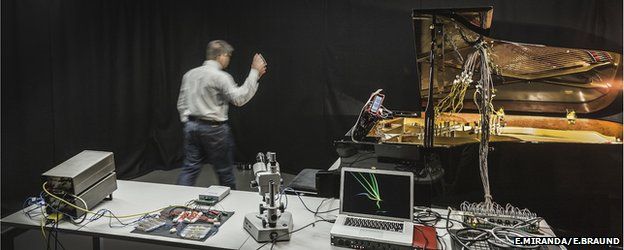Slime mould plays 'biomusic' duet
- Published

A duet for slime mould and piano will be premiered at an arts festival this weekend, giving new meaning to the term "culture".
Festival director and musician Eduardo Miranda has put the decomposition into composition: his new work uses cultures of Physarum polycephalum.
This mould is the core component of an interactive biocomputer, which receives sound signals and sends back responses.
The result is a musical duet between the simple organism and Prof Miranda, on piano.
"The composition, Biocomputer Music, evolves as an interaction between me as a human playing the piano, and the Physarum machine," Prof Miranda told the BBC's Inside Science programme.
"I play something, the system listens, plays something back, and then I respond, and so on."
The Physarum mould forms a living, evolving electronic component in a circuit that processes sounds picked up by a microphone trained on the piano.
As Ed Braund, a PhD student in the Interdisciplinary Centre for Computer Music Research at Plymouth University explains, tubules formed by Physarum have the electrical property of acting like a memristor, a variable resistor that changes its resistance in response to previously applied voltages.
Discovered only recently in solid state electronics, memristors have the capacity to be programmed by voltages, which is how they are being used in the musical biocomputer.
"The piano notes are transformed into a complex electrical waveform which we send through one of these Physarum tubules.
"The Physarum resistance changes as a function of the previous inputs, and the musical notes are then evolved into a new output that is then sent back to the piano.
"The biocomputer acts as a memory device," Eduardo Miranda adds.
"When you tell it to play back, it will scramble the notes you sent in. It may even generate some pitches that were not in the notes you played – the machine has a little bit of 'creativity'."
While the pianist plays the piano in the conventional way, using the keys, the biocomputer excites notes through small electromagnets hovering millimetres above the metal strings, imbuing the music with an ethereal tone.
Miranda compares his use of a biocomputer to the "aleatoric" techniques of the American avant garde composer John Cage (1912-1992), who turned to the Chinese book of changes i-ching, and to dice-throwing to control parts of his compositions.
"John Cage believed in chance, but not randomness. He wanted to harness a structure that was beyond his control. Here we have that effect, programmed in a living machine. I think this is John Cage’s dream realised."
Prof Miranda has long explored the use of computers in interactive pieces of electronic compositions, but values the simplicity of the Physarum processor.
"What I hear is very different from having a digital computer which I have programmed with strings of data – there is a component that is 'thinking', in an analogue, biological way. It’s not intelligent, but it’s alive. And that is interesting."
Biocomputer Music will be performed at the Peninsular Arts Contemporary Music Festival "Biomusic", on Sunday 1 March. Listen to Prof Miranda on Adam Rutherford's Inside Science programme on BBC Radio 4.
- Published15 February 2014
- Published5 July 2012
- Published22 January 2010